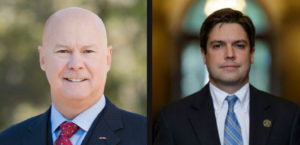Something special happened in flood-ravaged Marion County
July 12, 2019By Tom Mullikin and John Cleveland
Something very special happened in Marion County. S.C., last month. June 15, the day before Father’s Day, hundreds of volunteers descended on the town of Nichols, S.C. – In fact, as many volunteers as the population of the town itself. They were there to do the dirty and unglamorous work of clearing and cleaning ditches along the roadways and culverts in the flood-ravaged community. It was the first full-fledged demonstration of Gov. Henry McMaster’s S.C. Floodwater Commission in action; and it was a remarkable show of support by South Carolinians from across the state for their fellow citizens.
Over the past three years, Nichols had been flooded twice. First during Hurricane Matthew, then again during Hurricane Florence. In Sept. 2018, approximately four-to-six feet of rainwater from the Lumber and Little Pee Dee rivers spilled over into and blanketed the area, devastating residents who had just managed to rebuild from the flooding of 2016.
The problem in Nichols – as in many flood-impacted communities – is deferred maintenance of existing drainage systems. When debris and detritus is present to the extent it was in Nichols, there is no place for the water to go except out and into the town.
Upon arrival, the volunteers – including the governor, lieutenant governor, a congressman, a state senator, two state representatives, four mayors and 100 members of the S.C. State Guard – got to work removing tires, antifreeze, couches, chairs (and just about anything else you might find in a yard or garage) from Nichols’ roadside drainage and canal systems.
The difference was immediate. By the end of the day, volunteers had cleared 25,000-feet of roadside drainage, another 1.5 miles of canal, and they removed and replaced a major drainage pipe under Kemper Road.
As Gov. McMaster said, through “collaboration, communication and cooperation we can get things done.” His words were proven in Nichols, and it is surely the hope of all South Carolinians that this work and demonstration of unity and volunteerism will serve as a model throughout the state. But it’s only one step in the Commission’s broader plan to alleviate flooding in the Palmetto State.
The S.C. Floodwater Commission is a historic endeavor, bringing together stakeholders from across the spectrum of government, academia, law enforcement, the military and the non-profit sector to analyze and address the flooding issue comprehensively, as a single team. The Commission consists of ten task force groups, each with a different focus area: artificial reef systems, living shoreline, infrastructure and shoreline armoring, smart river and dam security, grid security, landscape beautification and protection, national security, stakeholder engagement, federal funding and economic development.
For six months, the Commission has analyzed each of these issue areas, syncing up mapping data, meeting with engineers, identifying weaknesses in our critical infrastructure and planning for big, “moonshot” ideas to be revealed in the coming months. Each task force is now in the process of submitting a draft report for the governor’s staff, which will, collectively, present a comprehensive picture of the problems we face and the solutions we must pursue.
Yet, as witnessed in Marion County, there is no substitute for face-to-face engagement and the healing power of fellowship. In a separate event following the Nichols cleanup, unheralded and uncovered by media, the group converged in nearby Sellers. Like so many communities throughout the state, Sellers has been ravaged by flooding. Of the 40 homes within the city limits, virtually all of them have been significantly damaged since 2016. Many people have left, though even more opted to stay – in many cases, due to a lack of resources. 86.6 percent of Sellers’ 263 residents are below the poverty level. With few available dollars and little hope of rebuilding, the situation is desperate.
You would not have known it in mid-June. In what can only be described as a joyous occasion, Commission members converged on Sellers to hear the concerns of residents and offer their support. There was hugging and crying. And there was progress. Volunteers planted the first of 500 trees which will offset stormwater and aid in groundwater infiltration, reducing the potential for flooding, erosion and runoff.
As representatives from federal, state, county and municipal government converged on Sellers, it became clear: this is how government is supposed to work.
Sellers, like many other communities, will need more resources – and no small amount of resolve. But compassion goes a long way, and the spirit of volunteerism witnessed last weekend proved that the Palmetto State’s best resiliency strategy is its people.
– Tom Mullikin is chair of the S.C. Floodwater Commission and the former commanding general of the S.C. State Guard.
– John Cleveland is director of policy and external communications for Gov. Henry McMaster.












